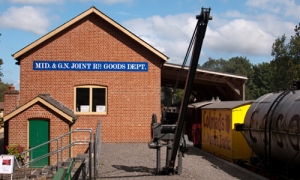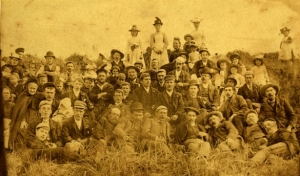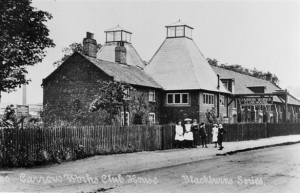By Wayne Kett
When Jeremiah James Colman was asked how he had made such a vast fortune from the sale of mustard he replied ‘I make my money from the mustard that people throw away on the sides of their plate’.
When, after the death of his father in 1851, 24 year old Jeremiah James Colman assumed control of the family business. It was a small local company selling modest amounts of mustard. In the space of 50 years he built the company into a global brand using innovative marketing techniques and through his hard-work, honesty and integrity as a business man.
In 1856, Colman’s employed just 200 people, by 1862 this had risen to 600 and by the time of his death in 1898 it was closer to 2,000. He expanded the range of products under production to include laundry blue, flour and starch.
The story of the rise of Colman’s and of the work and life of Jeremiah James Colman is fundamental to understanding the history of Norwich in the 19th century. Colman’s influence can be seen everywhere and his morals, actions and achievements drastically altered the lives of many thousands of people living in Norwich.
For this weeks blog I would like to focus on the life and work of Jeremiah James Colman and highlight some of the related objects we hold in our reserve collections.
There was a large fire on the 30th June 1881 in the mustard packing factory. After this Colman acquired a 600 gallon steam engine (see image below) for use at the site and employed a dedicated team of fire fighters.
This engine forms part of our collection and is currently on display in the Bridewell museum.
Here in the superstore we have many other objects used by the fire fighting department at Carrow Works.
The rapid growth of Colman’s Mustard runs counter to the narrative of 19th century industrial growth that is so well known. In an age characterised by child labour, unsafe working environments and long hours for low pay, Colman displayed a remarkable duty of care to his employee’s.
Many an industrialist claimed they could ill afford to treat their workers better or pay them more and to do so, would destroy their business and the nations economy. Colman demonstrated the ability to dramatically grow a profitable business whilst treating his employee’s with humanity.
20 years before parliament made any provision for compulsory education, Colman set up a school for his workers children. When the school opened, Colman sent a letter to each of his employee’s extolling the benefits of education.
Here are a few highlights from that letter:
‘In these days of progress, that man is sure to be left far behind, who has neglected the cultivation of his intellect while he who strives to improve his mind stands a fair chance of raising himself in the social scale’
‘Remember the motto of your Reading Society ‘KNOWLEDGE IS POWER’, power for advancement, power to be good and to do good, power to be happy and to cause happiness to others’
‘It is of the utmost importance that you should teach your children to be punctual, neat and industrious.’
A nursery was later established for younger children, a nurse, called Phillipa Flowerday was employed and a dispensary set up for the benefit of his workers. In 1872 he set up a self-help medical club for his workers, encouraging them to contribute, matching their contributions with his own donations.
An onsite kitchen was opened, this provided tea or coffee in the morning and a hot meal for lunch, charged at cost. Workers who were off sick long term would have food parcels delivered to them at home courtesy of the company (somebody was employed full-time to deliver these food provisions.)
The company owned hundreds of homes and accommodation was provided for many workers, but special provision was made for single women who were provided with low-cost accommodation. He even provided public houses in which his workforce could enjoy a pint or two!!
A clothing club was established; this made saving towards the cost of clothing much easier, additionally the company contributed to the savings scheme. From 1874 a dressmaking teacher was hired to help female employee’s learn new skills that could be used in the home and to save money. In fact a whole series of educational classes were provided free of charge to all employee’s.
Colman insisted his employee’s were insured against sickness or injury, the company ran its own scheme for workers who could choose between that or joining a friendly society. From 1864 the dispensary employed a doctor to work alongside the nurse.
When Jeremiah James Colman died he left £2,000 in his will to the employee’s trust and the money from this was used to set up a pension fund. By the time he had departed Colman had built up a system of nurseries, schools, medical care, food provision, housing and pensions. A system of protection for his workers from cradle to grave and 50 years before the creation of the welfare state!
Why did Colman feel the need to provide such assistance? He could very easily have turned a blind eye to the plight of his workers, like the majority of his contemporaries did. He was no social revolutionary, in an age of socially radical ideologies Colman was politically a liberal. He was however a devout Christian paying strict adherence to the Protestant religion. This drove his belief in a strong work ethic but also his compassion for his fellow man and his ethical approach to business. Colman’s brand of charity was that of self-help, he believed in giving to help people, but he believed that once helped people had a duty to do everything in their power to help themselves.
Such was Colman’s religious conviction; he had even been tempted to turn down the opportunity to run the family business. He feared it would impinge upon the time he could devote to religion and self improvement. He questioned the morality of wealth and feared he would become corrupted and greedy.
He was a close friend of four time Prime Minister William Gladstone, who offered Colman a baronetcy, Colman declined the offer saying:
‘anything I can do to promote the principles I have always supported … I am glad to do, but I much prefer that it should be without the reward or rank a title is supposed to give’.
So how was a small local company able to transform itself into one of the top 100 British companies in just under 50 years, whilst simultaneously providing a decent living for its workforce?
Marketing was a key to their success, and Jeremiah James Colman was the man driving this forwards. In 1855 they adopted the now instantly recognisable bright yellow packaging with the distinctive bulls head and in 1865 they gained a royal warrant from Queen Victoria. Colman’s products are still used by the Royal household today.

Colman’s box from our collection 1880-1900. This box would have originally contained 48 penny tins of mustard.
They were one of the first companies to really push forward the marketing of their products to a consumer market. As early as the 1840’s Colman’s made the decision to start selling their products in much smaller packages (penny tins). This enabled smaller amounts to be purchased more cheaply which opened up a huge new potential customer base.
Railway carriages like the one below were decorated in the distinctive brand colours to transport their goods across the country. Before the age of Television this allowed the whole country to see the Colmans imagery.

The Yellow carriage on the right is a re-creation of a Colman’s carriage. This one is on display at the fantastic William Marriott museum in Holt.
By the 1870’s Carrow had its very own marketing department, and by the late 1890s they had started hiring famous artists to create high quality advertising posters for them. Including the illustrator John Hassall and later the painter Alfred John Munnings.

Advert created by Alfred Munnings. Munnings was a famous artist renowned for his talent at drawing scenes with horses. He served in WW1 as a war artist. In modern times his artwork has sold for many millions of pounds.
Colman had a great sense of civic responsibility stating:
‘Men should go into municipal affairs to see what they could do for the town, instead of seeing what the town could do for them’.
At the young age of 29 he was elected to Norwich Town Council. He was sheriff in 1862-63, mayor 1867-68, in 1869 he became a magistrate for Norwich and then for Norfolk in 1872. In 1871 he was elected as a liberal MP for Norwich, serving for 25 years.
His political career was mixed, he did not thrive in the Houses of Parliament as a Liberal MP in part due to his poor oratory skills, but also he very quickly became disillusioned with national politics. He was however much more successful as a local politician he sought to end the corruption for which Norwich was well known.
He was a part of Norwich Young Men’s Mutual Improvement Society, this group met regularly and spent their time writing, reading and debating the great questions of the day focusing on politics, religion, society, and morality.
He was closely involved with the successful launch of the Eastern Daily Press in 1870 (a newspaper that is still going strong) and fought for and won having a preservation order placed upon the city walls.
Colman was one of the leaders of a subscription campaign that sought to argue for all public buildings in Norwich being used for the public benefit. By 1886 they had been successful in securing both the Castle and Blackfriars Hall for public use. At the time Colman was a trustee of Norwich Museums, whose collections were then housed in a purpose built building on Exchange Street. After closing as a prison the castle was offered to both the city and county councils for purchase, but they were unwilling to met such expense. Briefly the decision had been made to allow the castle to become a ruin, however banker John Henry Gurney purchased the castle, and it re-opened as the museum we know today.
In the winter of 1896 he visited Egypt with several family members, for the purpose of offering re-cooperation to his ill son Alan. Sadly Alan died in February 1897 and the family headed home, however Colman procured over 250 artifacts whilst there. In 1921 these were donated to Norwich Museums by his daughters and include an Egyptian shroud! Check out this British Museum blog to find out more about the shroud and Colman’s trip to Egypt.
After his son had died he purchased and donated the land that was used to build the extension of the Jenny Lind Hospital.
In the space of three and a half years Colman lost his son Alan his wife Caroline in 1895 and then his mother in 1898, himself dying at home in Corton, Suffolk shortly afterwards.
His funeral procession numbered 1200 people, which is perhaps the greatest indication of how important Jeremiah James Colman was to so many people in 19th century Norwich and in the 21st century we have much more than just Mustard to thank Colman for!!
If you want to find out more about Colman’s or Jeremiah James Colman check out:
Or to see some of the objects featured visit the superstore when we open for public tours in Spring 2014!! Including the Mustard Stamper (image below) which will be one of our ‘star objects’.












Reblogged this on Old School Garden.
LikeLike
an ancestor I am right proud of
LikeLiked by 1 person
He is one of my heros. Betty Elzea
LikeLike
Pingback: Saturday 21 October 2014. Hackney. | Every day's a Saturday
Hi
Does anybody know which Public Houses(names) were provided by Colman’s for their employees.
Thanks.
Trevor
LikeLike
Where did James colman go to school.?
LikeLike
Pingback: A Julian of Norwich Pilgrimage or My Days as an Industrial Spy – A Medieval Woman's Companion
Pingback: NORWICH: NO LONGER CUTTING THE MUSTARD? | The Norwich Radical
Pingback: As keen as - Expert Print Management
Pingback: The Profit On The Side Of The Plate! – Norfolk Tales, Myths & More!